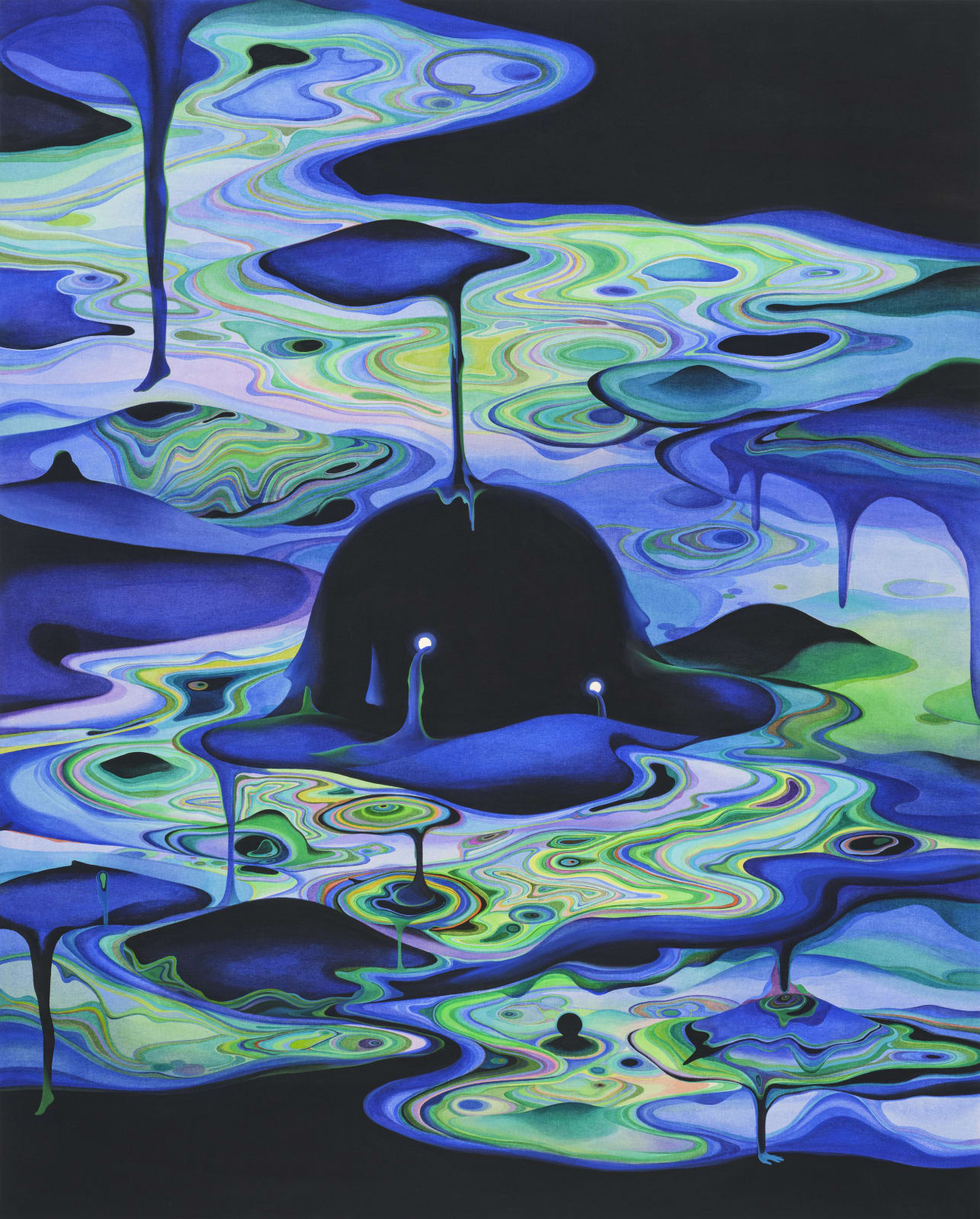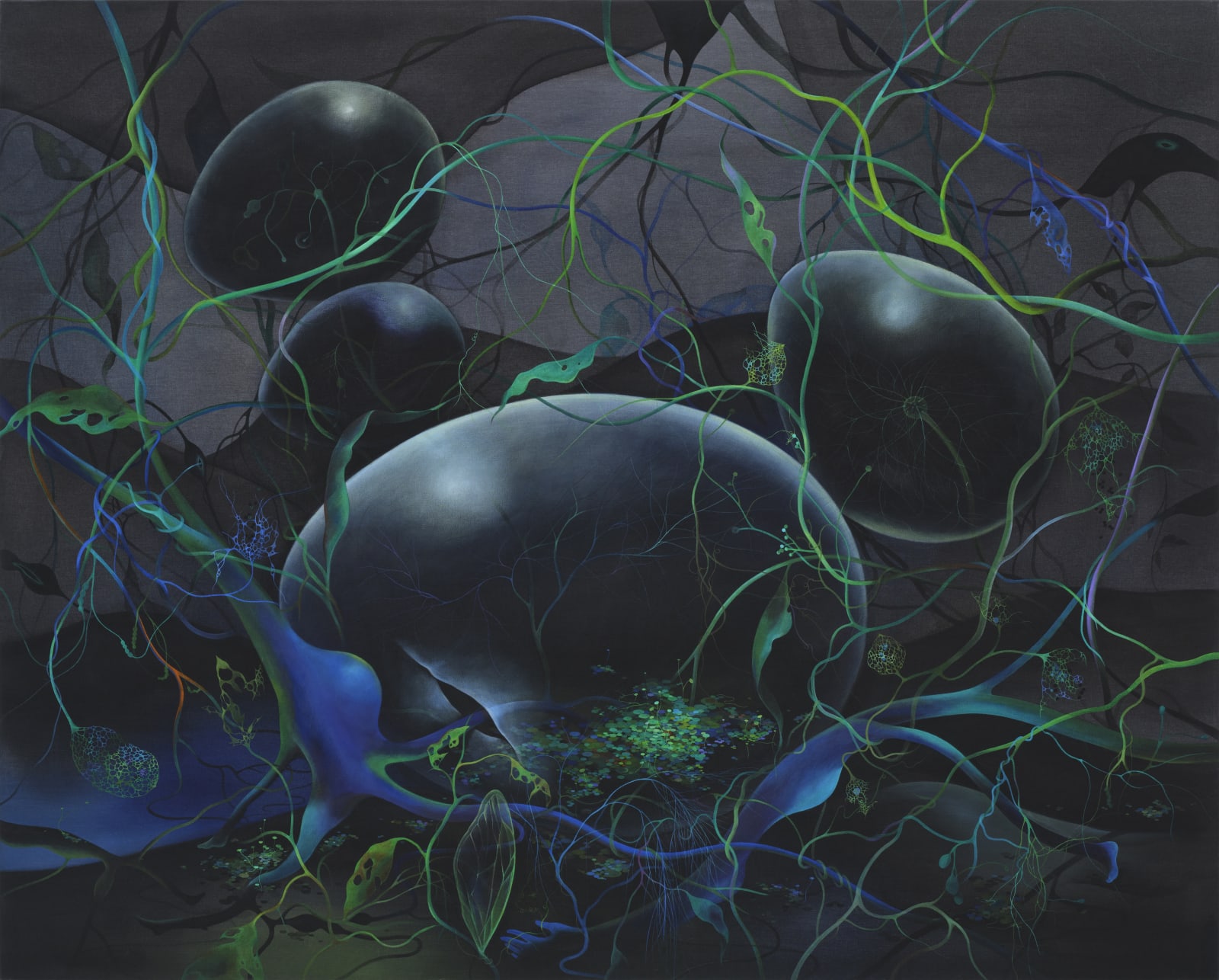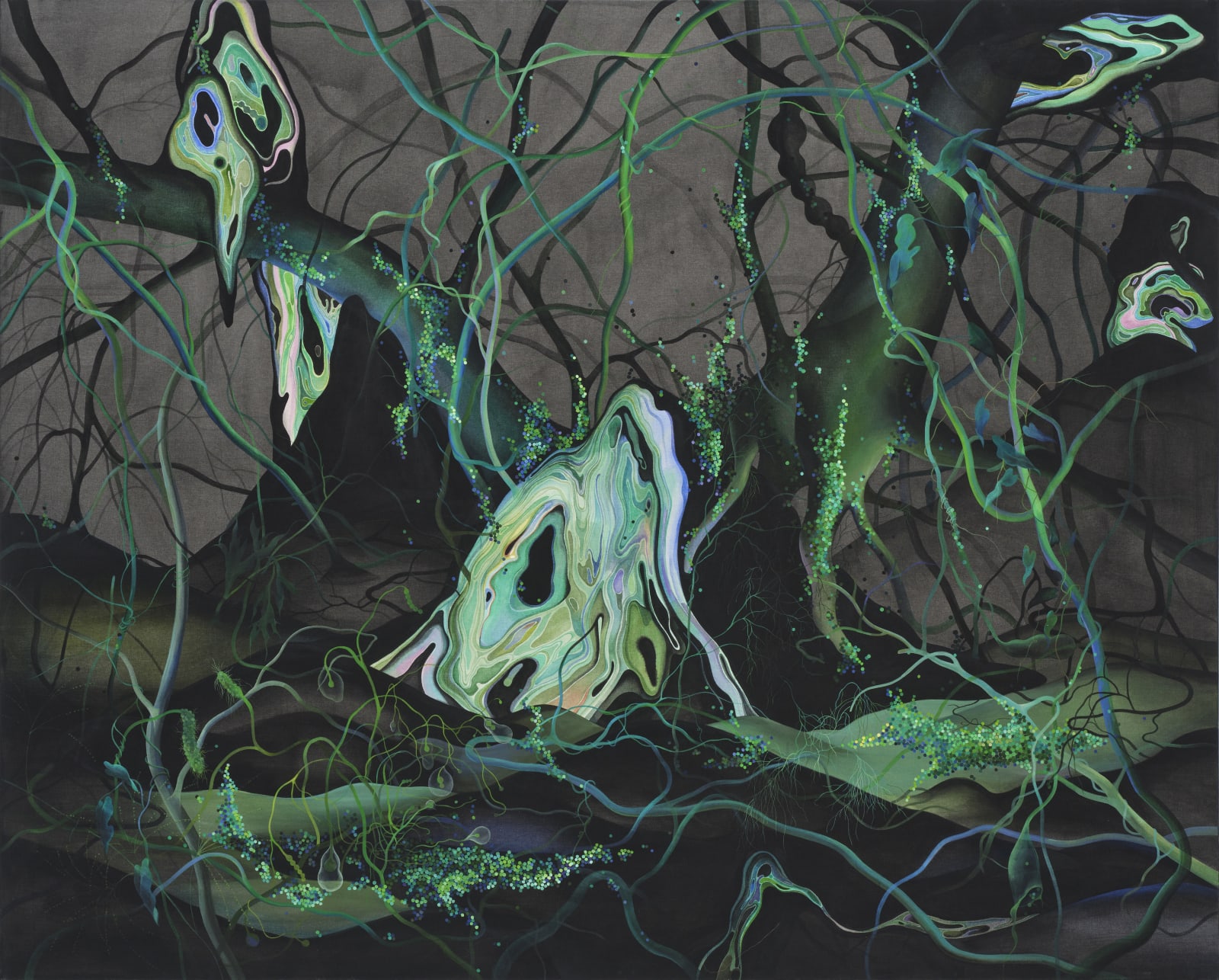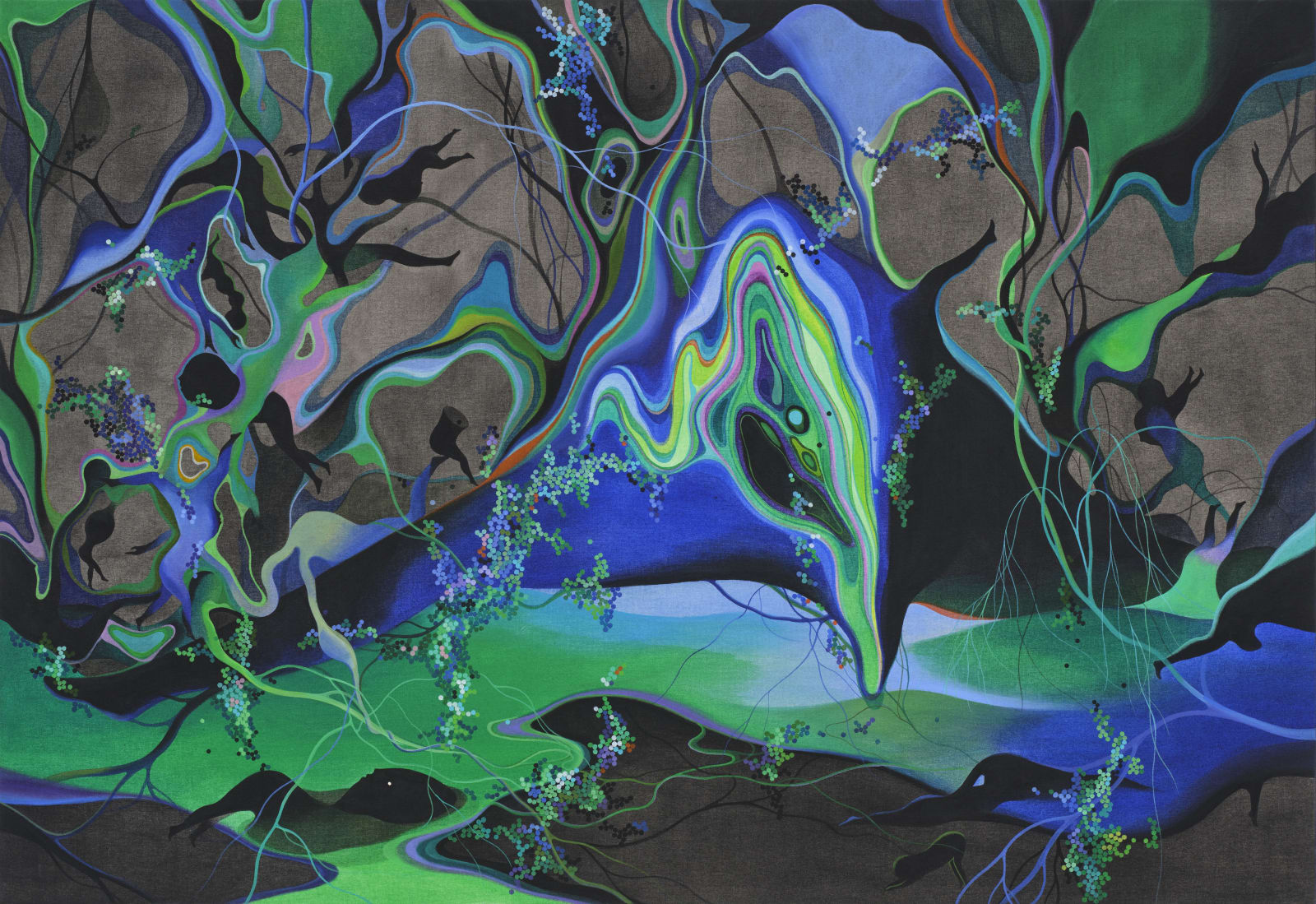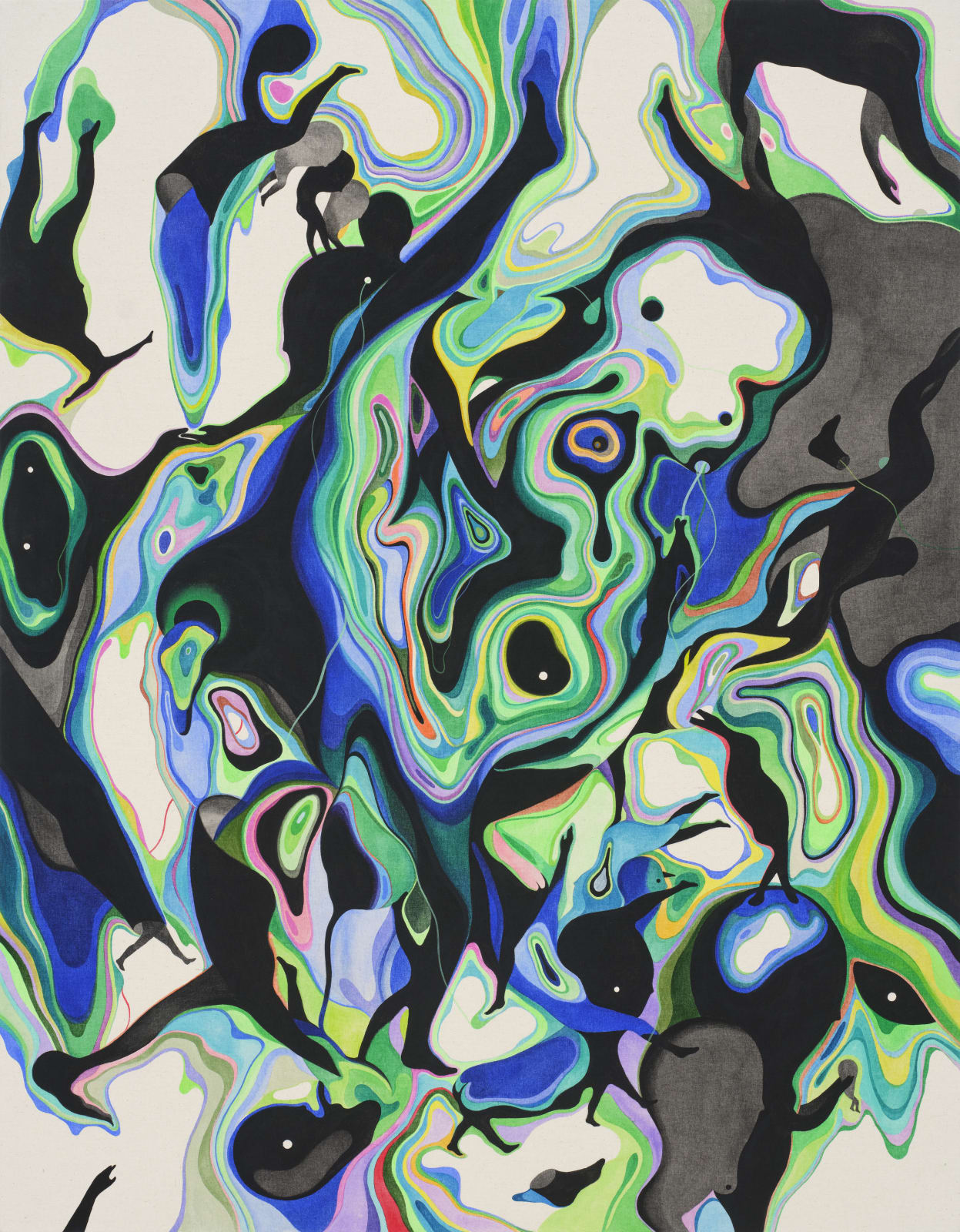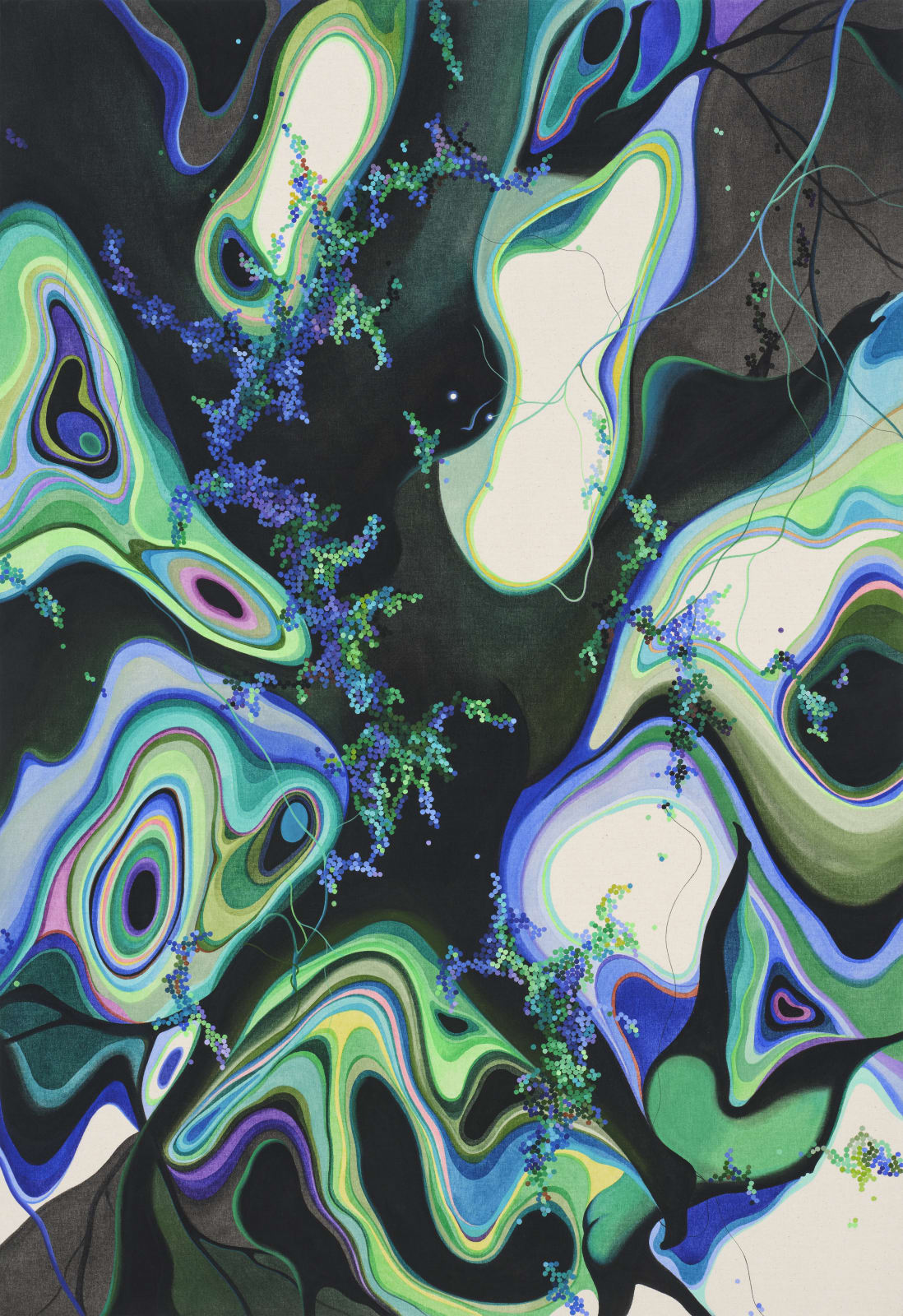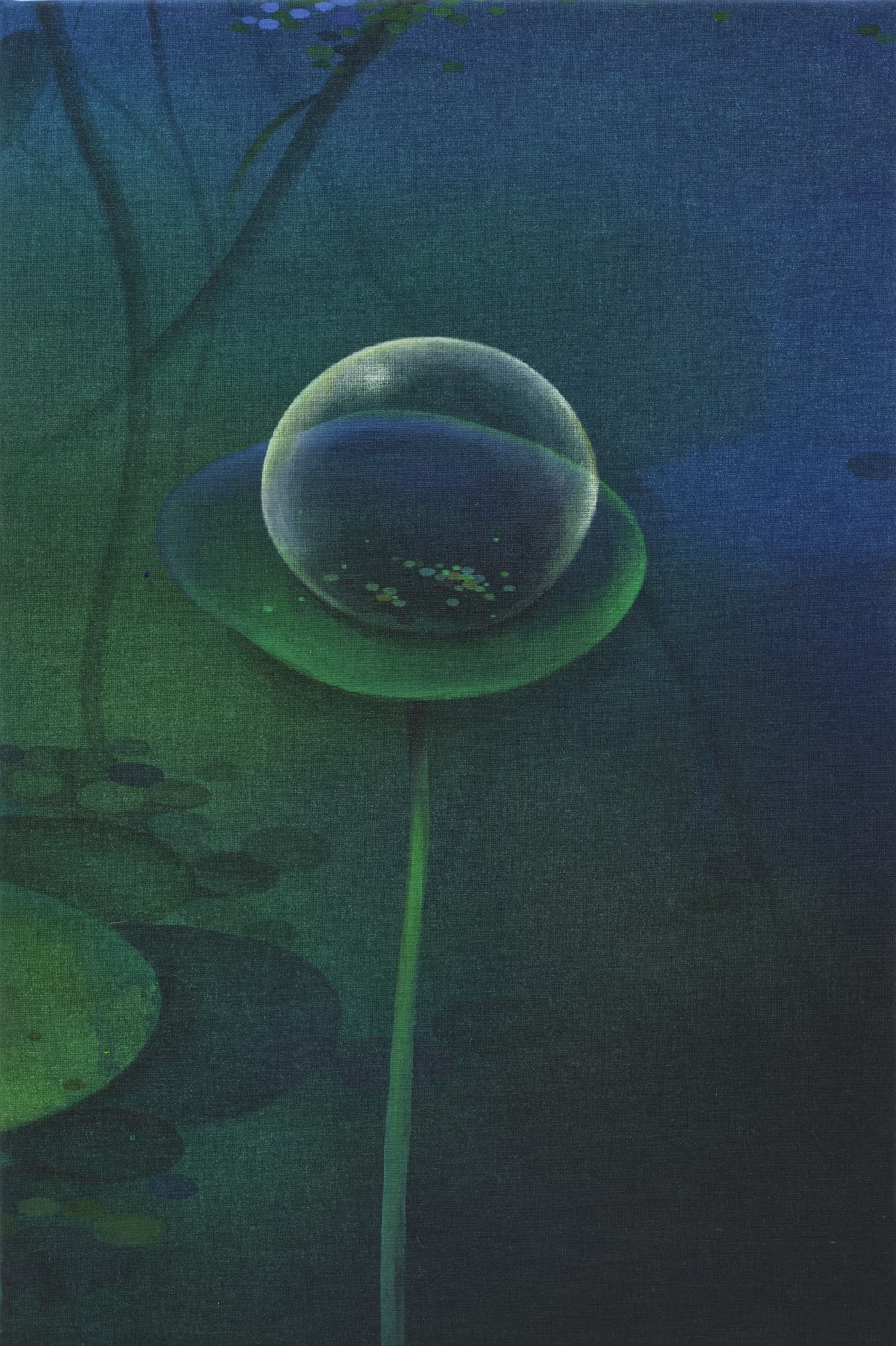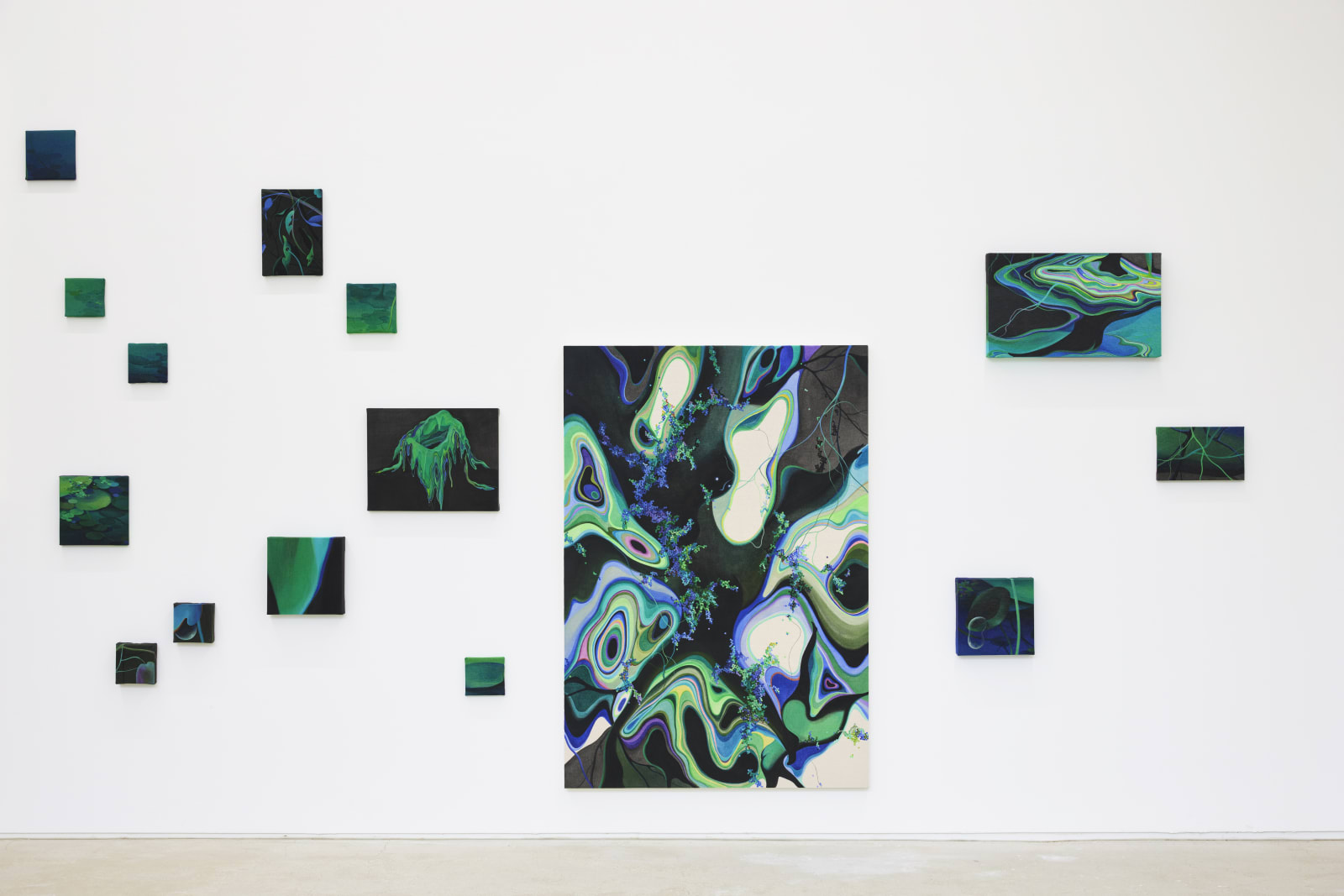허공에 차오르는 Rising in the voids: 박주애 Juae Park
박주애는 살면서 느끼는 갈등과 결핍을 작업의 모티프로 삼았다. 해외에 잠시 체류할 때 경험했던 외로움과 소외감은 캔버스 천에 보고 싶은 사람을 그리고 솜으로 채운 인형 작업의 계기가 되었다. 그리고 아이를 갖고 싶은 마음은 흙으로 그 마음을 담아낸 토템적인 도자기 작업의 시발점이었다. 자신의 고민을 솔직하게 드러내는 데 집중했던 그에게 매체나 장르는 그다지 중요하지 않았다. 오히려 다양한 매체를 습득하고 표현하는 과정은 작가에게 새로운 영감이 되고 삶의 여러 문제를 극복하는 하나의 수단이 됐다. 사실 그의 내면에는 회화에 대한 막연한 두려움과 망설임이 있었다. 이것이 작가가 그동안 드러내지 않았던 속마음이다.
이번 전시는 회화에 대한 두려움을 극복하기 위해 작가가 자신의 주변을 필사적으로 탐색한 과정을 담아냈다. 그는 스스로 ‘굶주린 들개처럼 세상을 킁킁거렸다’고 말한다. 그렇게 탐색하고 다닌 곳은 바로 숲이었다. ‘숲’에 작업의 소재가 있지 않겠냐는 막연한 생각에 제주도의 곶자왈을 돌아다녔다고 한다. 곶자왈은 화산 활동 중 분출한 용암류가 만들어 낸 불규칙한 암괴지대로 이끼와 덤불 등 다양한 식생을 이루는 제주도의 숲을 말한다. 그곳은 경작이 불가능한 버려진 땅이었지만, 그로 인해 오히려 다양한 동∙식물이 공존하는 독특한 생태계를 유지하고 있다. 작가는 넝쿨이 폭포처럼 쏟아져 내리고 이끼가 돌에 붙어 악착같이 살아가는 모습을 보며 자연이 갖는 무질서와 강한 생명력에 매료되었다.
박주애는 어수선하면서도 강한 생명력을 가진 곶자왈을 보며 자신과 다르지 않다고 생각하게 된다. 왜냐면 그 역시 정리되지 않은 복잡한 생각들과 그림에 대한 강한 열망으로 가득 차 있었기 때문이다. 어쩌면 그곳의 식생과 자신을 동일시 한 것은 작가도 제주도에서 태어나고 자랐기 때문인지 모른다. 그러니 자신이 나고 자란 자연을 표현하는 것은 곧 자신을 표현하는 것과 다름이 없다. 자연을 통해 학습한 선과 형태들이 바로 그림이 된 것은 아니다. 작가는 입체 작업에서부터 자연에 접근한다. 와이어를 구부려 줄기를 만들고 직접 바느질한 천으로 잎사귀를 만들어 곶자왈에서 흔히 볼 수 있는 넝쿨을 형상화했다. 전시 공간 안에서 자유롭게 뻗어나가는 넝쿨 작업을 보며 그는 이 모습을 캔버스에 옮겨내는 상상을 하게 된다.
캔버스 화면에서 복잡하게 얽혀있는 넝쿨은 캔버스 앞에서 헤매는 작가의 모습이다. 처음에는 넝쿨과 이끼 버섯의 형상을 인체와 접목해 은유적으로 자연을 표현했다. <흐르는>, <계절을 토해 내는 숲>은 자연을 소재로 한 초기작업이다. 자연이 만들어 낸 숲의 형상을 화면에 옮겨 담았다. 그는 이것이 ‘자연을 통해 그림을 배우는 과정’이었다고 말한다. 그림은 검은색, 파란색, 녹색이 주를 이룬다. 이 어둡고 습윤한 색조는 나무와 넝쿨이 우거져 빛도 잘 들어오지 않는 곶자왈의 모습을 반영한다.
이후에 식물의 형성은 생략되고 자연과 섞여 있는 (인간을 닮은) 생명체의 모습이 화면의 주인공이 된다. <허공에 차오르기>는 후반부 작업을 대표한다. 100호 캔버스가 4개로 구성된 이 대형 회화는 곶자왈을 은유하는 짙고 어두운 색조의 유기적인 선들과 생명체들이 화면을 가득 채운다. 이 생명체들은 대부분 분주하게 ‘어딘가’로 가고 있으며 때로는 쓰러져 있거나 녹아내리고 있다. 그들은 그림을 그리면서 겪는 작가의 감정과 태도를 반영한다. 캔버스 앞에서 분주하게 움직이고 좌절하고 포기하고 지치다가 다시 또 어디론가 열심히 달려가는 모습 말이다. 명확한 그림의 ‘목적지’가 존재한다면 캔버스 앞에서 그 누구도 방황하지 않을 것이다. 화가는 그저 고군분투할 뿐이다.
박주애는 자신의 작업이 ‘간증’과 같다고 말한다. 간증은 종교적으로 자기반성이나 종교 생활에 대한 경험담을 통해 성실한 신앙생활을 영위하는 활동을 의미한다. 공식적인 발화이지만, 어떤 특정한 형식에 얽매이지는 않는다. 솔직하게 자신의 이야기를 털어놓는 것이 형식이라면 형식일 것이다. 작가는 스스로 뭔가를 교정하거나 단점을 숨기지 않고 그 자체를 드러냄으로써 그림에 대한 의지를 보여주고 싶었다고 한다. 결국 (그리고 언제나) 그에게 작업이란 자신의 고민이나 힘든 상황을 ‘물질’로 치환하는 과정이다. 그리고 그 과정을 통해 상황을 긍정적으로 바라보고 극복할 수 있는 실마리를 찾아나갔다. 그는 전복된 상황을 작품으로 보여주는 것이 사람들에게 위로가 될 수 있다는 믿음을 가지고 있다. 절망적인 상황에서도 이것을 어떻게 돌파할지가 제일 중요한 법이다.
Juae Park regards her work as an embodiment of her personal struggles and wants. Throughout her life, she has turned such experiences into motifs for her artwork. Her previous works of cotton-stuffed canvas dolls depicting people she missed motivated by feelings of loneliness and alienation during temporary stays abroad. Her yearning for childbearing and motherhood inspired her ceramic works, which manifest this sentiment in a totemic form. Park has always been unreservedly open about her personal concerns, expressed across media and genres. Learning to work with and express herself through unfamiliar media and genres became a path for inspiration and means to overcome many of her concerns. In the beginning, Park was hesitant about painting. She was unsure. She kept it hidden.
The personal journey she undertook to overcome that fear culminates in this exhibition, which captures the artist's relentless exploration of her surroundings. She describes her effort to that of a wild canine, hounding for a scent. Her perusal for meaning led her to the forest. It was an instinctive decision, and she was drawn to the Jeju Gotjawal Park, where she wandered about. The geography of the area is distinct with irregular rock formations created by ancient volcanic and seismic activity now overgrown with moss and flora. The land itself does not lend itself to cultivation, but this has allowed a unique ecosystem of diverse plants and animals to flourish. The artist was fascinated by the verdant vitality and the flourish within the nature’s chaotic state, especially by the cascade of vines and the tenacious cling of rock moss.
Observing the vibrant yet chaotic Gotjawal, Park realized she was not much different. She too, was filled with complicated and unorganized thoughts and a strong desire to add a layer--painting--upon a surface. Perhaps such echoes can be traced back to her tie to the island. After all, it was the island where she was birthed and raised. Describing the nature of her upbringing was to a large extent an expression of herself. The lines and forms from nature were not immediately painterly. Park approaches nature through three-dimensional work. She shaped wires into the form of common vines found in Gotjawal, bent them into shape and hand-stitched fabric to form leaves. As she envisions those vines and leaves unfurl and sprawl into the exhibition space, she also transfers the imagery unto the canvas.
The intricately intertwined vines on canvas screen reflect the artist’s wandering uncertainty. At first, the shapes of vines and moss mushrooms were combined with the human body to express nature metaphorically. Flowing and The Trees Emit the Seasons were nature paintings in that regard. Whatever form was given to the trees by nature, she transferred unto canvas, describing it as “a process of allowing nature to guide my painting”. The screen is dense with blacks, blues, and greens. The dark and watery tones reflect the dark and damp ambiance of Gotjawal where trees and vines grow dense enough to subdue light.
Plants then taken on an abbreviated form and the composition presents a subject (likely a person) amidst nature. Rising in the Voids is an apt representation of those later works. This large painting consists of 4 No.100 canvases, filling the screen with dark, organic lines and creatures--metaphors of Gotjawal. These life forms, most of them apparently headed somewhere actively, while others appear to have fallen or in a state of dissolution. They are passing reflections of the artist’s inner state while painting: frantic, frustrated, crestfallen, exhausted, then diligently focused and directional. If paintings had clear destinations, none would wander before the canvas. The artist is simply struggling.
Testimony is how Juae Park describes her work. She neither attempts to correct nor hide her shortcomings, instead, she candidly shares them as a demonstration of determination, and perhaps, of faith. She is nonchalant about the statement, as she seems free of format and style. The only guiding principle here is authenticity. The artist shares that there is something to be said about sheer commitment, which can transcend any need for self-correction and hiding of shortcomings. To her, the work is always a process of transforming her troubles and wants into something more tangible and material. Through it, she finds positive perspectives and solutions, and no matter how subversive the situations in life, the candidness of her paintings will resonate and comfort others. Forward and throughward is key in moments of uncertainty and despair.

